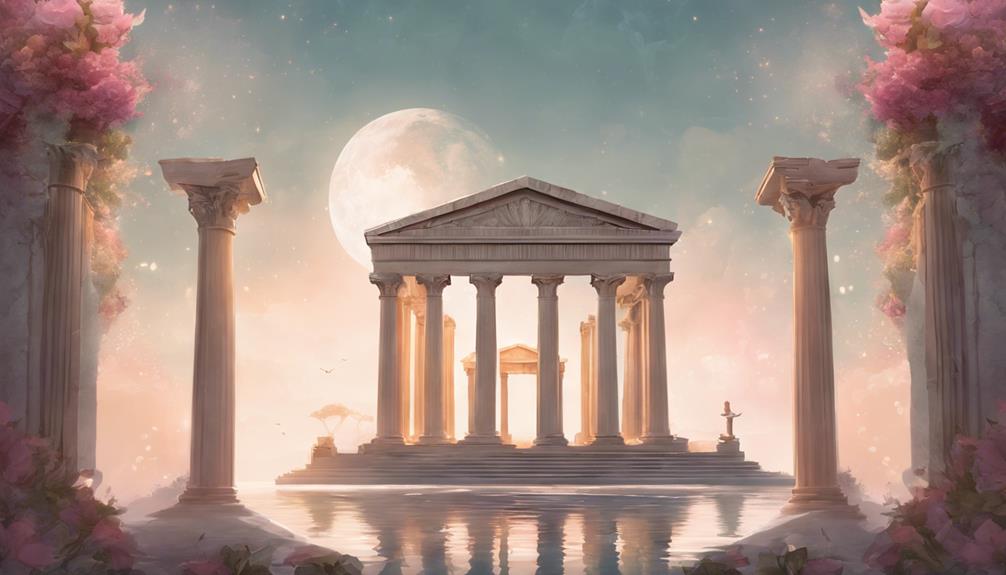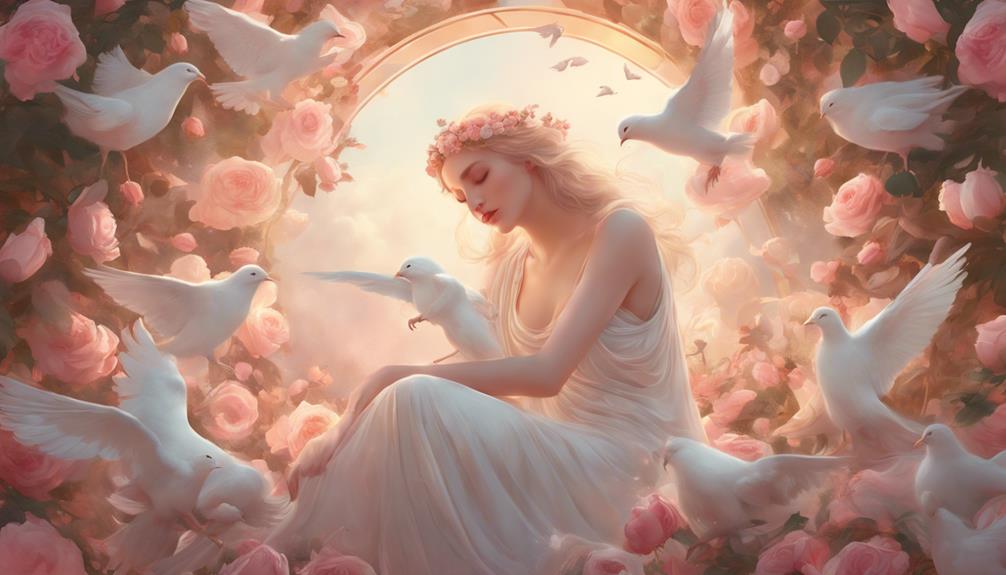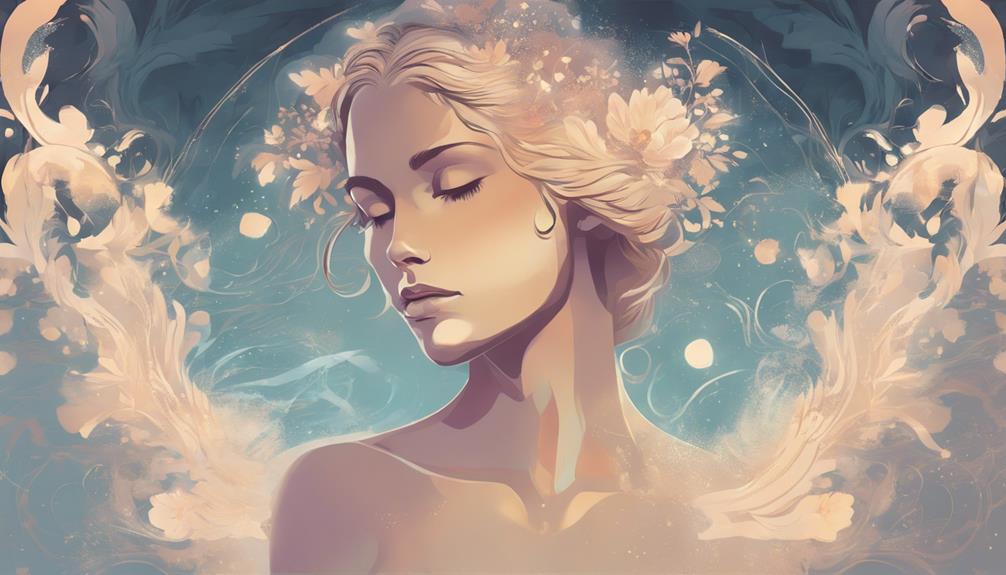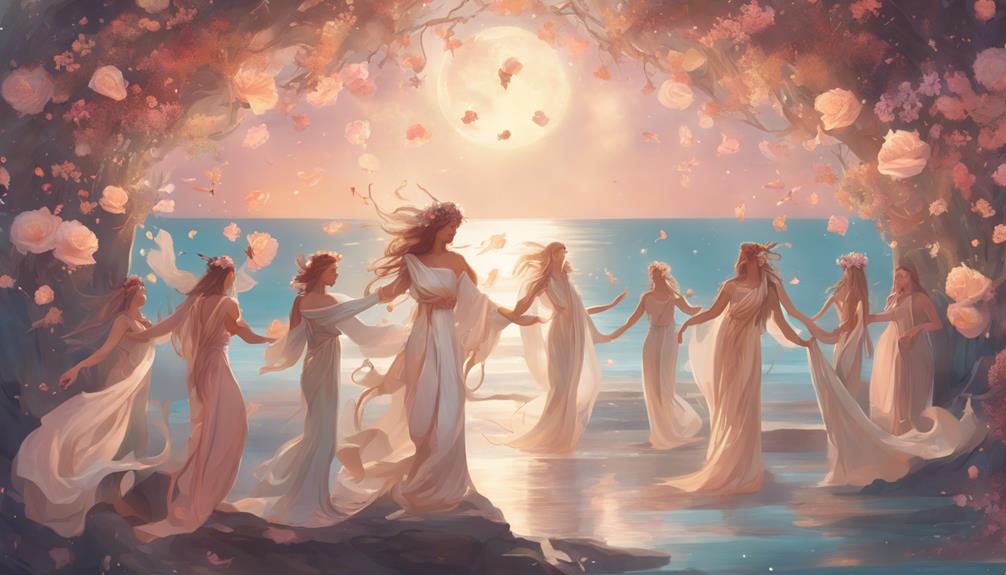Summary
- 1 Origins and Birth
- 2 Symbols of Aphrodite
- 3 Great Myths
- 4 Aphrodite in art
- 5 Temples and Worship
- 6 Roman counterpart of Venus
- 7 Aphrodite and Eros
- 8 Cultural impact
- 9 Modern representations
- 10 Aphrodite in literature
- 11 Holidays and Celebrations
- 12 Inheritance and Influence
- 13 Frequently asked questions
- 13.1 What are the lesser known epithets or titles of Aphrodite?
- 13.2 How does Aphrodite influence current beauty standards?
- 13.3 Are there any lost myths about Aphrodite?
- 13.4 How did the ancient philosophers interpret the role of Aphrodite?
- 13.5 What were the ancient rituals for invoking Aphrodite's favor?
Aphrodite is the Greek goddess of love and beauty, who emerged either from the foam of the sea or was born of Zeus and Dione. She embodies attraction and desire with symbols such as shells, roses and doves. Her myths, such as the Judgment of Paris and the tale of Adonis, highlight her influence on passion and destiny. Throughout history, artists have celebrated her, with famous works such as Botticelli's "The Birth of Venus." Temples dedicated to her hosted festivals and rituals celebrating love. Even today, Aphrodite's legacy resonates in art and culture, shaping our ideals of beauty and romance. There is still much to discover about her enduring influence.
Origins and Birth

The origins of Aphrodite are as fascinating as the goddess herself, rooted in both myth and mystery. You will find that her birth is a tale that captures the imagination and speaks to the very essence of beauty and love. In one popular version of her story, Aphrodite is born from the foam of the sea. According to this myth, after the sky god Uranus was toppled and his severed parts thrown into the ocean, the sea began to boil and form foam. From this frothy mixture, Aphrodite emerged fully formed, radiant and beautiful.
If you are more interested in the alternative narrative, Hesiod's "Theogony" provides another fascinating account. Here, Aphrodite is described as the daughter of Zeus, the king of the gods, and Dione, an ancient goddess. This version emphasizes her divine lineage and powerful connections within the pantheon of Greek gods.
Regardless of which version you prefer, both stories highlight Aphrodite's extraordinary beginnings and set the stage for her role as the embodiment of love, beauty, and desire. These myths not only enrich your understanding of her character, but also illustrate the timeless appeal and complexity of her origins.
Symbols of Aphrodite
When you dive into the symbols of Aphrodite, you will notice that she is often associated with iconic representations such as the sea shell and the mirror. Her connection to sacred plants, such as myrtle and roses, further emphasizes its role in love and beauty. In addition, mythological animals as doves and swans are frequently linked to her, adding further nuance to her charming persona.
Iconic representations
Many symbols such as the bird, flower and shell are closely associated with Aphrodite, symbolizing her eternal beauty and affection. These symbols are not arbitrary; they represent various aspects of her core and are easily recognized. Let us delve into some of her most iconic representations.
- Bird: The bird symbolizes peace and affection. Aphrodite is often depicted with birds or even riding a chariot drawn by them. This gentle creature represents the pure and loving side of the goddess.
- Flower: Flowers are another significant symbol. The beauty, fragrance and thorns of the flower reflect the intricate nature of love-enchanting but sometimes painful. Aphrodite is believed to have fashioned the first red flower from her blood.
- Shell: The shell, particularly the scallop, is associated with the emergence of Aphrodite from the sea. You may have seen artwork depicting her emerging from a shell, emphasizing the divine and enigmatic aspect of her birth.
Understanding these symbols helps you appreciate the complex mythological fabric of Aphrodite. They demonstrate how deeply she is intertwined with the essence of love and beauty, making her a timeless figure worthy of further study.
Sacred Plants
Some plants are sacred to Aphrodite, symbolizing various aspects of love, beauty and passion. One of the most iconic is the rose, often associated with romance and deep affection. The enchanting scent and vibrant colors of the rose make it a fitting emblem for the attractiveness of Aphrodite. You may have noticed how roses are a classic gift to express love, a tradition that has ancient roots in the worship of the goddess.
Another plant closely associated with Aphrodite is the myrtle. It represents eternal love and fertility. People in ancient Greece used myrtle in weddings and other ceremonies to invoke Aphrodite's blessings. The evergreen nature of the plant symbolizes a love that lasts through all seasons.
Let us not forget the apple, another sacred plant. In mythology, the golden apple given to Aphrodite symbolized beauty and desire. Apples are often seen as symbols of love, and their sweet taste can remind you of the pleasures of loving relationships.
Finally, the anemone flower is related to the goddess. Legend has it that anemones were born from the blood of Aphrodite's lover, Adonis. This flower represents the delicate and sometimes fleeting nature of love and beauty.
Mythological animals
In the world of mythology, the alluring presence of Aphrodite is often accompanied by animals that symbolize her divine characteristics of love and beauty. These creatures are more than just companions; they represent various aspects of her essence and influence.
- Doves: Doves are perhaps the most iconic animals associated with Aphrodite. They symbolize peace, love, and fidelity, all fundamental elements of Aphrodite's domain. Doves are often depicted pulling her chariot across the heavens, a testament to their close association with the goddess.
- Sparrows: Sparrows, though small, have great significance. In ancient legends, they represent true love and passion. These birds were believed to be sacred to Aphrodite, often accompanying her in various stories and works of art, serving as messengers of romance and desire.
- Swans: Swans embody grace and beauty, reflecting the divine charm of Aphrodite. They are often seen in artistic representations gliding beside her in serene waters. Their elegance and tranquility perfectly reflect the calming and charming nature of the goddess.
Great Myths

Aphrodite's most famous myths reveal her power over love, beauty and desire, weaving stories that still enchant us today. One of the best known stories is the Judgement of Paris. In this myth, Paris, a prince of Troy, he had to choose the most beautiful goddess from Hera, Athena and Aphrodite. Each goddess offered him a bribe, but Aphrodite promised the love of the most beautiful woman in the world, Helen of Sparta. Paris chose Aphrodite, leading to the famous Trojan War When he kidnapped Elena.
Another fascinating myth is the tale of Pygmalion and Galatea. Pygmalion, a talented sculptor, fell in love with a statue he had created. Moved by her devotion, Aphrodite brought the statue, Galatea, to life. This story highlights her ability to ignite love where it seemed impossible.
Finally, there is the myth of Adonis, a beautiful mortal loved by Aphrodite. Despite her efforts to protect him, Adonis was killed by a wild boar. Her death saddened her deeply and it is said that her blood turned into anemone flowers, a symbol of beauty and loss.
These myths show how Aphrodite's influence goes beyond mere appearances, influencing hearts and fates.
Aphrodite in art
When you think of Aphrodite in art, you might imagine the famous Renaissance paintings that capture her beauty and grace. But don't forget that modern artists have their own unique interpretations of this timeless goddess. Together, these works show how the image of Aphrodite has evolved over the centuries.
Representations of Renaissance art
During the Renaissance, artists embodied the essence of Aphrodite in vibrant paintings and intricate sculptures, bringing to life the goddess of love and beauty. This period saw a revival of classical themes, and Aphrodite, with her enchanting charm, became a favorite subject. Artists interpreted her in various ways, emphasizing her divine beauty and alluring presence.
To help you understand these Renaissance representations, here are three notable examples:
- 'The Birth of Venus' by Sandro Botticelli: This iconic painting shows Aphrodite emerging from the sea on a shell, symbolizing her birth. Her graceful pose and flowing hair perfectly capture her ethereal beauty.
- 'Venus of Urbino' by Titian: In this work, Aphrodite is portrayed lying on a sofa, emanating sensuality and trust. It is a celebration of its physical form and the intimate nature of love.
- 'Venus Italica' by Antonio Canova: Although slightly later, this sculpture embodies Renaissance ideals, showing Aphrodite in a modest and alluring pose. It emphasizes her being the epitome of classical beauty.
Modern Interpretations
As we move from the Renaissance to modern times, you will find that artists continue to be inspired by Aphrodite, reimagining her in innovative and different ways. Unlike classical depictions of perfect beauty and grace, modern interpretations often delve into deeper themes. Contemporary artists play with her image to comment on social issues, personal identity, and even the concept of beauty itself.
Take, for example, the surreal works of Salvador Dalí. He presents Aphrodite in fragmented forms, challenging traditional ideas and making you question what beauty really means. Pop artists such as Andy Warhol have also used her image to criticize consumerism and the commercialization of beauty.
In photography, artists such as Cindy Sherman have revisited Aphrodite through self-portraits, examining the role of women in society. Her work makes you think about how beauty and identity are constructed and perceived.
Street artists have also embraced Aphrodite. Murals and graffiti depicting her image are popping up in urban settings, blending classical beauty with rough, modern contexts. This juxtaposition invites you to see Aphrodite not just as a goddess but as a timeless symbol that evolves with society.
Temples and Worship

Throughout ancient Greece, temples dedicated to Aphrodite became focal points for worshippers seeking her blessings of love and beauty. These sacred places were not just buildings; they were centers of devotion and community gatherings. If you wanted to connect with Aphrodite, you went to one of her temples to offer prayers, gifts and even participate in festivals.
Visiting these temples, you would have found a range of activities and rituals designed to honor the goddess. Here are three key aspects of the temples of Aphrodite that stood out:
- Altars and Statues: Central to every temple was a large altar where you could leave offerings. Statues of Aphrodite depicted her in stunning beauty, often surrounded by symbols of love.
- Festival: Special festivals such as Aphrodisia celebrated her influence. During these events, you would witness processions, banquets, and various forms of entertainment, all aimed at pleasing the goddess.
- Priestesses and Oracles: Temples often housed priestesses who acted as intermediaries between you and Aphrodite. They conducted rituals and provided guidance, sometimes uttering oracles believed to be messages from the goddess herself.
These elements made the temples of Aphrodite essential to Greek culture, offering a space where love and beauty were revered and celebrated.
Roman counterpart of Venus
Although its name has changed, the essence of Aphrodite continued to live on in Roman mythology as Venus, the goddess of love and beauty. It might interest you to know that while the Romans adopted many aspects of Greek culture, they gave their gods new names and sometimes slightly different attributes. Venus was not only a direct copy of Aphrodite; she also represented fertility and victory, expanding her influence in Roman society.
In Roman culture, Venus was celebrated with numerous festivals and had many temples dedicated to her. One of the most famous is the Temple of Venus Genetrix, which emphasizes its role as mother of the Roman people. This temple, built by Julius Caesar, highlighted the importance of Venus in the Roman state religion.
You can see Venus' influence in Roman art and literature, where she is often depicted similarly to Aphrodite-beautiful, charming and powerful. Statues, paintings and coins depicting Venus were widespread, emphasizing her central role in Roman life.
Understanding Venus helps you appreciate how the Romans viewed love and beauty. They saw these qualities not only as personal attributes, but as essential to the prosperity and success of their society.
Aphrodite and Eros

You might be curious as to how they are connected Aphrodite and Eros. Their relationship goes back to its origins in mythology, where Eros is often depicted as his son or close companion. Together, they symbolize the powerful forces Of love and attraction in many ancient stories.
Origins of their relationship
The relationship between Aphrodite and Eros has its roots in ancient Greek mythology, where Eros is often depicted as the son and constant companion of the goddess of love and beauty. Their bond is not only familial; it is deeply symbolic. Eros, the god of desire and attraction, complements Aphrodite's dominion over love and beauty. This makes their relationship one of the most intriguing in mythology.
To better understand the origins of their relationship, consider these key points:
- Birth of Eros: In many myths, Eros was born from Aphrodite and Ares, the god of war. This union symbolizes the complex interplay between love and conflict.
- Role in the Myths: Eros often assists Aphrodite in her efforts, using her arrows to ignite love and passion among both gods and mortals. Their combined influence shapes countless stories of romance and heartbreak.
- Mythological Symbolism: Their relationship highlights the dual nature of love-both its beauty and its potential for chaos. Eros is not just a helper; he is an essential force that amplifies Aphrodite's power.
Understanding their origins helps you appreciate the depth of their bond and the important roles they play in Greek mythology.
Symbolism in Mythology
The relationship between Aphrodite and Eros is rich in symbolism, showing the intricate dance between love and desire In mythology. Aphrodite, the goddess of love and beauty, represents the pure and all-encompassing power of love. On the other hand, Eros, his companion and sometimes son, embodies the more passionate and impulsive aspects of desire. Together, they illustrate how love and desire are often braided, each influencing the other.
You can think of Aphrodite as the nurturing aspect of love, while Eros brings the spark that ignites the passion. In many legends, Eros is depicted with a bow and arrows, striking gods and mortals with sudden and uncontrollable desire. This image reminds us that desire can be unpredictable and overwhelming, a force from which even gods cannot escape.
Aphrodite and Eros also teach us the importance of thebalance. Love without desire can become stagnant, losing its vitality. Likewise, desire without love can be empty and unsatisfying. Their relationship encourages you to see love as a dynamic experience and faceted, where both tender affection and fiery passion play crucial roles.
Cultural impact
Throughout history, her influence has permeated art, literature and culture, shaping our understanding of love and beauty. You can see the impact of Aphrodite everywhere, and not just in ancient temples or old myths. Her essence has been captured and reinvented in countless ways, making her a timeless icon.
- Art: From the splendid statue of Venus de Milo to Botticelli's famous painting, 'The Birth of Venus,' artists have drawn inspiration from Aphrodite to represent ideal beauty and romantic attractiveness.
- Literature: Writers have woven his stories into their works, delving into themes of passion, desire and the complexities of relationships. For example, Shakespeare often alluded to her in his sonnets and works, adding layers of meaning and emotion.
- Popular culture: The symbolism of Aphrodite extends to fashion, music, and even modern-day advertising. Brands use her image to evoke a sense of elegance and attraction, capitalizing on the universal appeal of love and beauty.
Modern representations

You might be surprised to see how the legacy of Aphrodite continues to thrive in today's world, from movies and TV programs to the social media and beyond. Modern media often draw inspiration from her image to symbolize beauty, love, and desire. For example, in movies and TV programs, characters inspired by Aphrodite often embody these qualities, captivating audiences with their charm and attractiveness.
Social media influencers also regularly channel the essence of Aphrodite. They share beauty tips, fashion tips e perspectives on relationships, all aimed at helping followers embrace their own inner goddess. The hashtag #Afrodite is even trending, highlighting posts that celebrate the beauty and the 'self-love. It is evident that the influence of the goddess extends far beyond the ancient myths.
In the world of fashion and cosmetics, brands often use themes related to Aphrodite to evoke a sense of timeless beauty and elegance. Products named after her promise to elevate your natural appeal, strengthening her connection to beauty and love.
Art and photography also continue to represent Aphrodite, often reinventing her in contemporary contexts. These modern representations keep her soul alive, reminding us that the ideals she embodies are still relevant today.
Aphrodite in literature
Aphrodite's attractiveness has fascinated writers for centuries, weaving her into countless literary works exploring themes such as love, beauty and desire. You will find her presence in ancient texts, poems and modern novels, each delving into different aspects of her divine allure. Understanding how Aphrodite has been portrayed in literature can offer you a glimpse into humanity's timeless quest for love and beauty.
- Homer's Iliad and Odyssey: In these epic poems, Aphrodite often plays a significant role. For example, her influence in the Iliad is crucial in the events leading up to the Trojan War. Her actions, fueled by love and desire, shape the story and the fate of the characters.
- Ovid's Metamorphoses: This collection of mythological tales highlights the transformative abilities of Aphrodite. Ovid presents her not only as a goddess of love, but also as a figure capable of profound changes and impacts on mortals and gods.
- Modern Novels: Aphrodite also appears in contemporary literature, often symbolizing the eternal quest for beauty and romantic fulfillment. Novels such as Madeline Miller's 'The Song of Achilles' reinterpret her influence in new and fascinating ways.
Holidays and Celebrations

Celebrations in honor of Aphrodite, such as the ancient festival of Aphrodisia, highlight her enduring influence on human culture and the timeless appeal of love and beauty. These festivals were held in various parts of Greece, particularly in cities such as Athens and Corinth. During Aphrodisia, people gathered to pay homage to Aphrodite through rituals, banquets and offerings. They often decorated her statues with flowers and performed dances and songs in her honor.
You will find that these celebrations were not just an act of worship; they also brought communities together. People exchanged gifts and shared stories of love and romance, strengthening social bonds. The festival was a reminder of the importance of love and beauty in everyday life, encouraging people to value these ideals.
In the present day, although ancient rituals may no longer be practiced, the spirit of Aphrodisia can still be seen in various cultural events and celebrations of love. Think of Valentine's Day, for example. Although its origins are different, it revolves around expressions of love and affection. By understanding these ancient celebrations, we gain insight into how deeply rooted the concepts of love and beauty are in human society.
Inheritance and Influence
While the festivals and celebrations of Aphrodite showed her importance in antiquity, her legacy and influence continue to shape our understanding of love and beauty today. You will find her impact in various aspects of modern culture, from art to psychology. Here's how:
- Art and Literature: The image of Aphrodite has inspired countless artists and writers. From Renaissance paintings to contemporary novels, her portrait often symbolizes idealized beauty and romantic love.
- Psychology: The concept of the 'Aphrodite archetype' in Jungian psychology represents the essence of love, sensuality and creativity. This archetype helps you understand the different dimensions of human relationships and attraction.
- Pop Culture: The influence of Aphrodite is evident in movies, TV shows, and even fashion. She is often cited as a symbol of beauty and desire, shaping the way we perceive these qualities in the modern world.
Understanding the legacy of Aphrodite gives you a richer perspective on how ancient myths continue to influence contemporary society. It is fascinating to see how a deity from millennia ago continues to play a role today in shaping our ideals and expressions of love and beauty.
Frequently asked questions
What are the lesser known epithets or titles of Aphrodite?
When you think of Aphrodite, you probably think of love and beauty. But did you know that she also has some lesser-known epithets? She is called 'Pandemos,' meaning 'of all people,' showing its universal appeal. Another title is 'Anadyomene,' meaning 'she who rises from the sea,' referring to her birth. There is also 'Urania,' highlighting its celestial aspect. These titles give you a richer understanding of its many facets.
How does Aphrodite influence current beauty standards?
Aphrodite's influence on modern beauty standards is enormous. One can see her impact in the way society values physical attractiveness and romance. Advertising, fashion and even social media often promote beauty ideals that reflect her timeless appeal. People still chase the concept of perfect love and beauty, much like how Aphrodite was worshipped. So the next time you admire a beauty trend, remember that it is probably inspired by her.
Are there any lost myths about Aphrodite?
Yes, there are lost myths On Aphrodite. The ancient stories were not always written down, and the oral traditions often faded over time. Some myths may have been forgotten or modified as they were passed down. One can imagine how tales about her might have included more adventures and details about her relationships and powers. It is fascinating to think what stories we might not know about her rich mythological history.
How did the ancient philosophers interpret the role of Aphrodite?
Ancient philosophers saw Aphrodite not only as a goddess of love and beauty. They believed she symbolized the powerful force of attraction that holds the universe together. Her influence was not limited to romantic love, but extended to harmony and unity in nature and human relationships. By understanding the role of Aphrodite, one can appreciate how love and beauty were considered essential for balance and order in the world.
What were the ancient rituals for invoking Aphrodite's favor?
To invoke Aphrodite's favor, you would engage in rituals like offering flowers, perfumes and incense. You could visit its temples and leave gifts such as beautiful shells or crafted objects. Ceremonies often included the singing of hymns and prayers dedicated to her. Sometimes, people would pour out libations Of wine or honey. By showing reverence and beauty, you hoped to gain Aphrodite's blessings in love and harmony in your life.
